Post-war use of German bombers
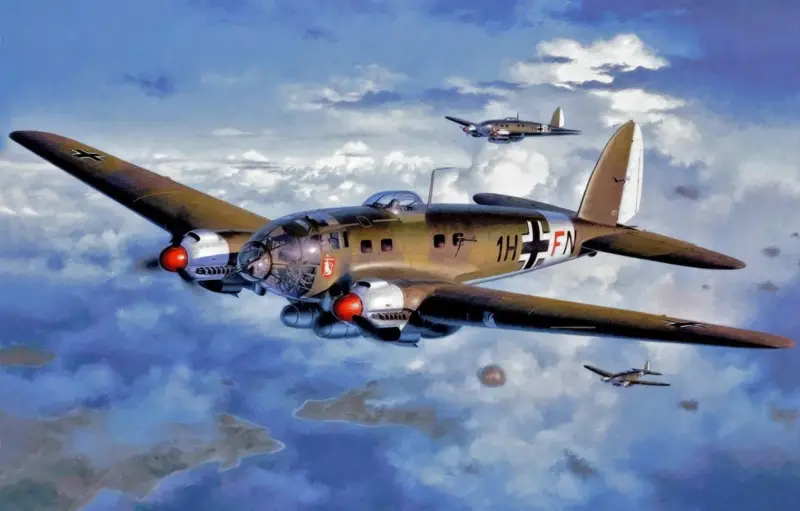
Relatively little known is the post-war use of bombers designed and built by the Third Reich.
Before the start of World War II, Germany actively offered some types of bombers on the foreign market, and after September 1, 1939, it supplied them to its allies.
In the first post-war decade, German-made bombers were operated in a number of countries, and some models that were of the greatest interest were tested in the USSR, USA and Great Britain.
Dornier Do 17
History The development of this aircraft began in 1933, when the airline Deutsche Luft Hansa AG ordered a high-speed twin-engine mail and passenger aircraft from Dornier Werke GmbH. The designers of the Dornier company, who by that time had experience in building flying boats, used existing developments and, taking into account the most advanced trends in the world aircraft industry, designed an all-metal monoplane with an upper wing and a spaced tail unit. The long, narrow fuselage had a duralumin frame and smooth metal skin. Particular attention was paid to aerodynamic perfection.
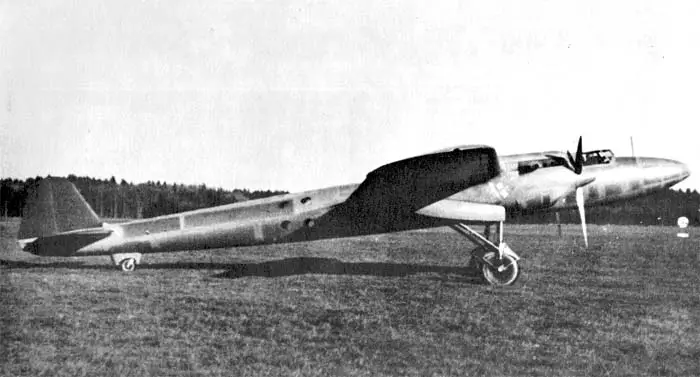
Do 17VI
Experimental aircraft Do 17VI with v-shaped twelve-cylinder liquid-cooled BMW VI 7,3 engines with a power of 750 hp each. With. took off on November 23, 1934. During testing, the aircraft, nicknamed the “Flying Pencil,” was able to accelerate in horizontal flight to 330 km/h, and there were deficiencies that threatened safe operation in civilian use. aviation, was not identified.
At the same time, even before the start of mass production, it became clear that the Do 17 is poorly suited for civilian use. The passenger compartment was very narrow and had to be divided into two isolated cabins, access to which was very inconvenient, making it difficult to board passengers and load luggage. After test flights conducted in October-November 1935, Lufthansa abandoned the aircraft.
But the career of the Do 17 did not end there, since the military became interested in the aircraft, which was fast by the standards of the mid-1930s and could be used as a bomber. After thorough tests carried out in the summer of 1935, the Ministry of Aviation, demanding a number of changes to the design, which made it possible to use the Do 17 as a bomb carrier, placed an order for 11 prototypes.
In the spring of 1936, weapons testing took place on the Do 17V4 modification. The Do 17V5 modification received Hispano-Suiza 12 Ykrs engines with a take-off power of 775 hp. s., with which the maximum speed reached 391 km/h. On the Do 17V6 and V9 prototypes, a glazed nose was installed, where the navigator-bombardier was now located and a bomb sight was installed.
Instead of the first passenger cabin, a radio operator's station was equipped in front of the wing. In place of the second passenger cabin, a bomb bay was placed between the wing spars. The designers considered that the high speed of the new aircraft would make it difficult to intercept it, so they decided to keep the defensive armament to a minimum. A blister with one 7,92 mm MG 15 machine gun appeared on top behind the cabin.
Serial production of the Do 17 was carried out at the Dornier Werke GmbH, Blohm & Voss, Henschel-Werke and Siebel Flugzeugwerke factories. The first serial modifications of the aircraft were assembled in the winter of 1936–1937. The bomber version was designated Do 17E-1, and the reconnaissance version was designated Do 17F-1.
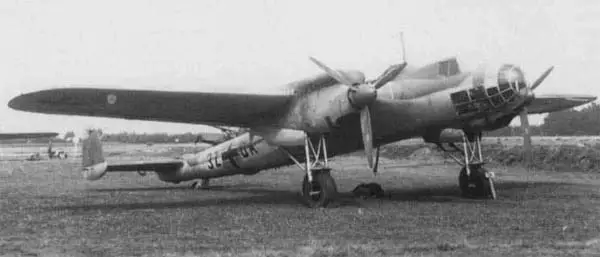
Do 17F-1
The bomber could carry 500 kg of bombs. Overload – up to 800 kg. The reconnaissance version was distinguished by the fact that it did not have a bomb sight, and an additional fuel tank and cameras were installed in the bomb bay.
The defensive armament of the first production aircraft consisted of only one 7,92 mm MG 15 machine gun in the upper blister. But it was soon increased to three machine guns. An additional MG 15 appeared, firing down through the hatch in the floor of the radio operator's cabin. The third MG 15 protected from frontal attacks by fighters, and the navigator fired from it.
In the spring of 1938, tests began on an aircraft with a new front part, on which the blister of the upper defensive firing point seemed to merge into one with a well-glazed canopy of the pilot's cockpit.
The new bomber, designated Do 17Z, had good controllability and maneuverability, but due to the new expanded cabin, it was necessary to install more powerful engines to maintain speed data.
The Do 17Z-2 modification bomber with a maximum take-off weight of 8 kg received Bramo 850R-323 engines, which developed a power of 1 hp during takeoff. With. The maximum speed at an altitude of 1 m was 000 km/h. Cruising - 3 km/h. Practical ceiling – 500 m. Practical range – 410 km. Bomb load – up to 300 kg. Crew – 8 people. The shooters now have additional rifle-caliber machine guns at their disposal, firing through the side windows.
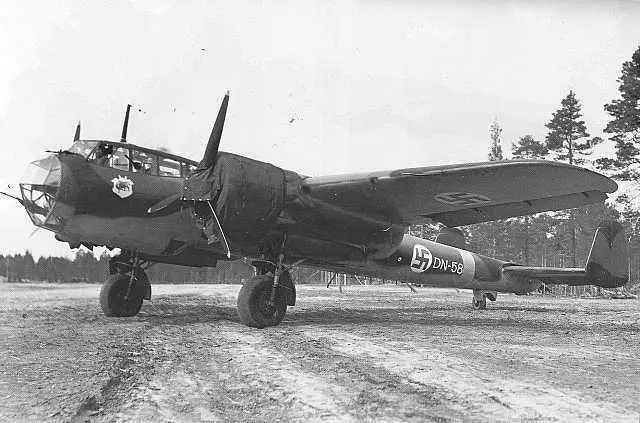
Finnish Air Force Do 17Z-2
Based on the Do 17Z-2 bomber, a modification of the Do 17Z-3 reconnaissance bomber was produced, which could take on board two automatic cameras, as well as 500 kg of bombs.
According to official data, 1940 Do 2 aircraft of all modifications were built on German assembly lines until the first half of 139.
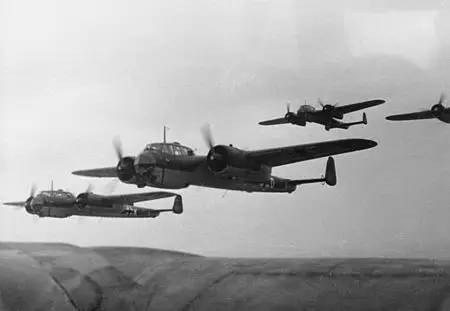
Until April 1939, Yugoslavia purchased 37 Do 17K aircraft. Then the production of Do-17Kb1 under license was mastered at the aircraft plant in the city of Kraljevo. Yugoslav aircraft were equipped with Gnome-Rhône Mistral Major engines with a power of 870 hp. pp., as well as weapons and equipment of Belgian and Czechoslovak production. Before the German invasion began in April 1941, the Yugoslav Air Force operated 60 Do 17K bombers. Subsequently, some of them were captured by the Germans and transferred to Croatia. Romania received ten German-built Do-17s from the summer of 1942 to March 1944.
Since 1940, 11 Do-17P reconnaissance aircraft have been operated in Bulgaria. By the end of 1943, Germany transferred another 23 Do-17s of various modifications. One Do 17M in cargo version was used until 1948.
To strengthen the strike potential of its own air force, Finland acquired a dozen Do 1942Z-17 bombers in 2.
Finnish Dornier bombers first actively fought against the USSR, and after Finland left the war in 1944, these same planes bombed German troops in the north of the country. By May 1945, ten aircraft were lost in battle or crashed in flight accidents. The last Finnish Do 17Z-2 was written off in 1952.
The air forces of Francoist Spain had 20 Do-17E and 15 Do 17F-1. Some of these machines flew until the early 1950s.
The Swiss Air Force operated one interned Do 1940Z-17 until the end of the 2s, which landed at Basel Airport in April 1940.
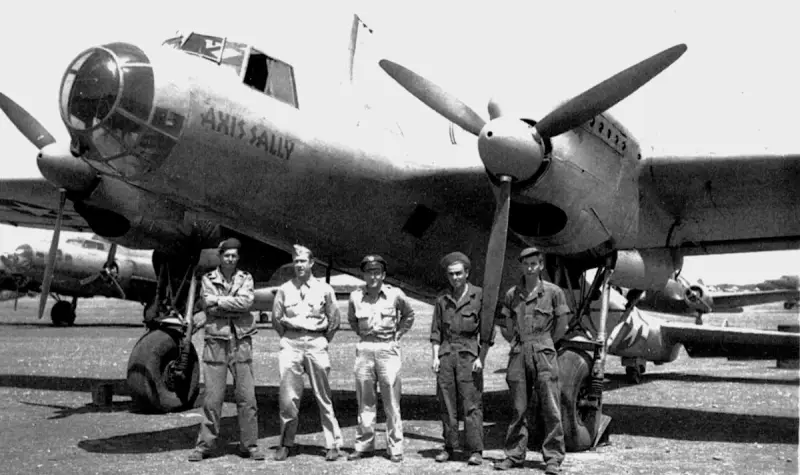
Do 17E Axis Sally
After the end of World War II, one Do 17E, known as the Axis Sally, was delivered to the United States, where it took part in demonstration flights in 1946.
Heinkel He 111
This aircraft, one of the symbols of German militarism during the Second World War, owes its appearance largely to another product of the Heinkel Flugzeugwerke company - the He 70 Blitz.
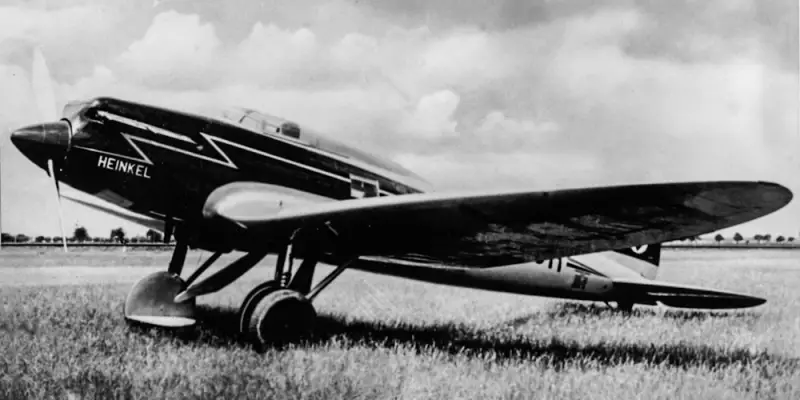
He 70 Blitz
A single-engine monoplane with retractable landing gear, which took off in 1932, due to the combination of high aerodynamic perfection and a powerful engine, had a high flight speed by the standards of the first half of the 1930s.
Although, in addition to the postal and passenger version, Heinkel also built Molniya bomber and reconnaissance modifications, the military wanted a more heavy-duty twin-engine bomber with an increased flight range.
The aircraft, designated He 111, was often called Doppel-Blitz (Double Lightning) for its resemblance to the He 70. Although this machine was built by order of the Luftwaffe, the management of the Heinkel Flugzeugwerke company decided to play it safe, and the designers initially designed two options: a bomber and a passenger airliner.
The first prototype He 111V1, which took off on February 24, 1935, was equipped with 12-cylinder liquid-cooled BMW VI 6,0Z engines with a power of 660 hp. With. The aircraft showed encouraging results, and other prototypes soon followed.
The passenger He 111V2, capable of carrying 10 people, took off four weeks after the first prototype. It could be visually distinguished from the bomber by the lack of glazing in the nose and by the windows in the passenger compartment. The flight range reached 1 km. Cruising speed was 900 km/h.
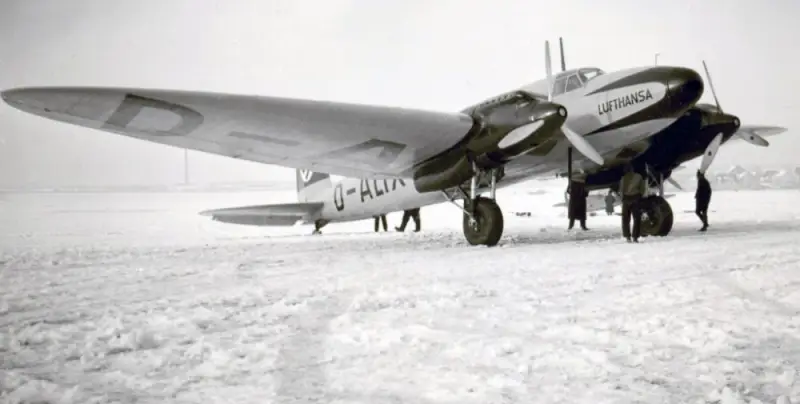
Not 111C
Since 1936, seven passenger aircraft, designated He 111C, have been operated by Lufthansa.
The first ten pre-production He 111A bombers had an elongated glazed nose section, which housed the navigator-bomber's workplace. The plane could carry up to 1 kg. For defense against fighters there were three rifle-caliber machine guns.
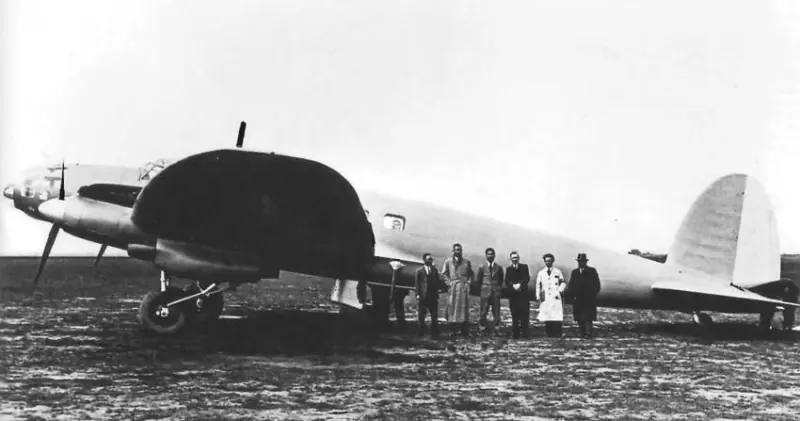
Not 111A-0
However, after testing, Luftwaffe representatives refused to accept these bombers. The military was not satisfied with the fact that the fully equipped aircraft required too long a runway, became very inert in the air, and the flight speed dropped sharply. Subsequently, six He 111A bombers, which were abandoned by the German military department, were sold to China.
Flight performance has improved due to the use of more powerful engines. In January 1937, serial He 111B-1s with modified ailerons, new equipment and DB 600C engines with 850 hp began to arrive in combat units. With.
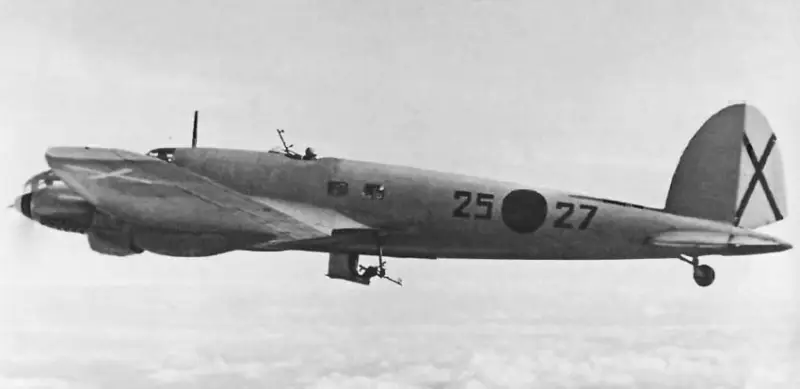
He 111B-1
The next modification of the He 111B-2 was equipped with DB 600CG engines with a power of 950 hp. With. with additional radiators.
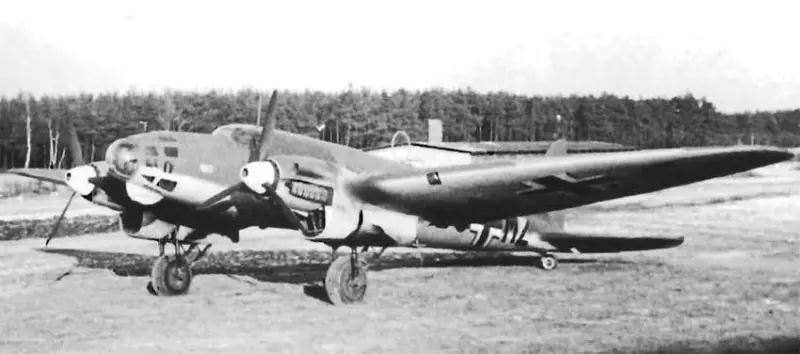
He 111B-2
The He 111B-2 bombers compared favorably with the first He 111A. The bomb load increased to 1 kg, the maximum speed increased to 500 km/h, and the aircraft could rise to a height of 344 m.
The variant that underwent its baptism of fire in Spain was the He 111E. The main difference between this modification and the He 111B was the use of different engines and the ability to place bombs on an external sling.
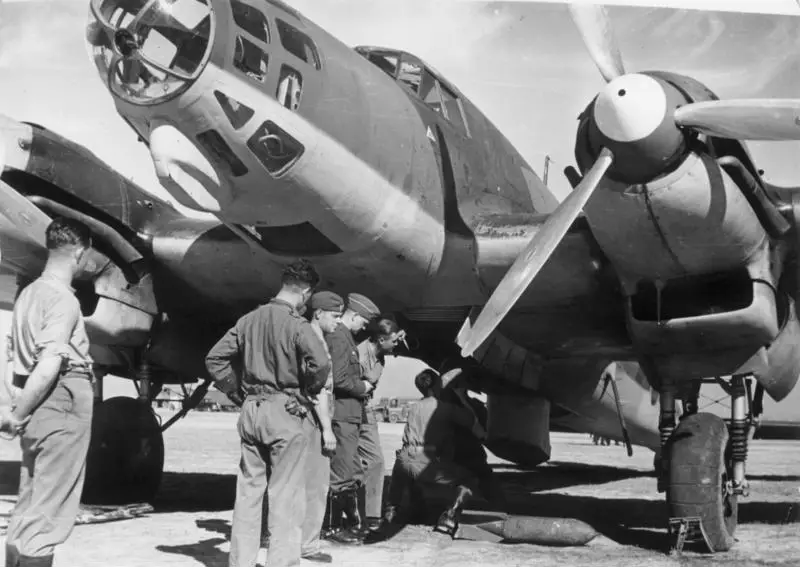
Bomber He 111E Condor Legion
Further improvement of the He 111 was achieved by increasing engine power, using new on-board equipment, improving production technology, aerodynamics and crew working conditions. They tried to reduce vulnerability from attacks by enemy fighters by increasing the number of defensive firing points and the caliber of weapons, as well as the use of armor, protected fuel tanks and fire-fighting systems.
The He 111P bombers, which appeared in 1938, differed from earlier models in their DB 601A-1 engines with a take-off power of 1 hp. With. But the most important change was the introduction of a fully glazed “stepless” cabin with very good visibility.
The He 111R-4 modification aircraft with a maximum take-off weight of 13 kg on an external sling could carry two bombs of 500 kg caliber. Defensive armament consisted of three MG 1 machine guns, which were later reinforced with three more MG 800s.
The He 111N family of bombers became the most popular and advanced. Thus, the He 111N-16, which had a maximum take-off weight of 14 kg with two Jumo 000F-211 engines with a power of 2 hp each. With. could reach a maximum speed of 1 km/h. Cruising speed at an altitude of 300 m is 440 km/h.
The flight range reached 2 km. The service ceiling is 300 m. The internal bomb bay could accommodate up to 8 kg, the total load weight, taking into account the suspension of bombs outside, was up to 500 kg. Defensive weapons included: a 2 mm MG FF cannon, up to seven 000 mm MG 3 or MG 600 machine guns, one 20 mm MG 7,92. Crew - 15 people.
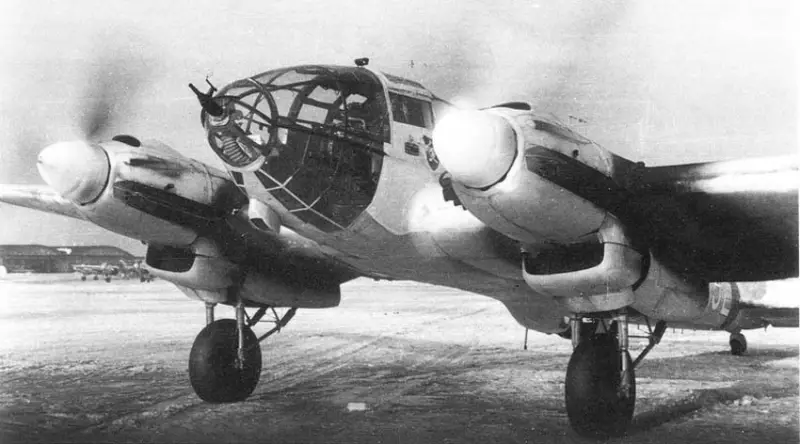
Not 111N-16
In total, more than 50 serial modifications of the He 111 are known. In addition to bomber variants, modifications were produced designed to launch cruise missiles, torpedo bombers, tugboats for landing gliders, aircraft for secretly delivering saboteurs behind enemy lines, and even night fighters. Until September 1944, about 7 examples were built in Germany.
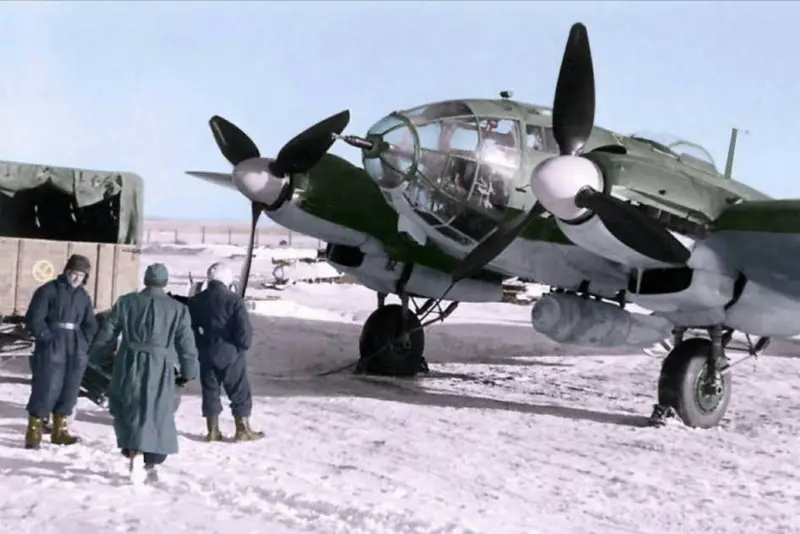
Production took place at Heinkel Flugzeugwerke in Marien, Berlin, Oranienburg and Rostock, Norddeutsche Dorniewerke in Wismar, ATG in Leipzig, Arado Flugzeugwerke GmbH in Babelsberg, Brandenburg-Havel and Warnemünde, Junkers Flugzeug und Motorenwerke AG in Dassau.
Not 111 were exported to Bulgaria (2 aircraft), Hungary (16), Spain (130), China (6), Romania (32), Slovakia (5) and Turkey (28). The He-111 was also produced under license in Romania (30 aircraft) and Spain (200 aircraft).
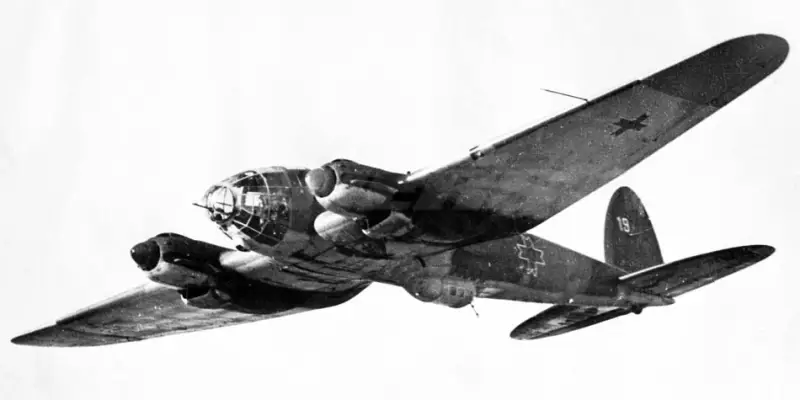
Romanian He-111N-3
After the end of World War II, several captured He-111 late modifications were used for passenger and transport transportation in the interests of the British occupation contingent in Western Europe.
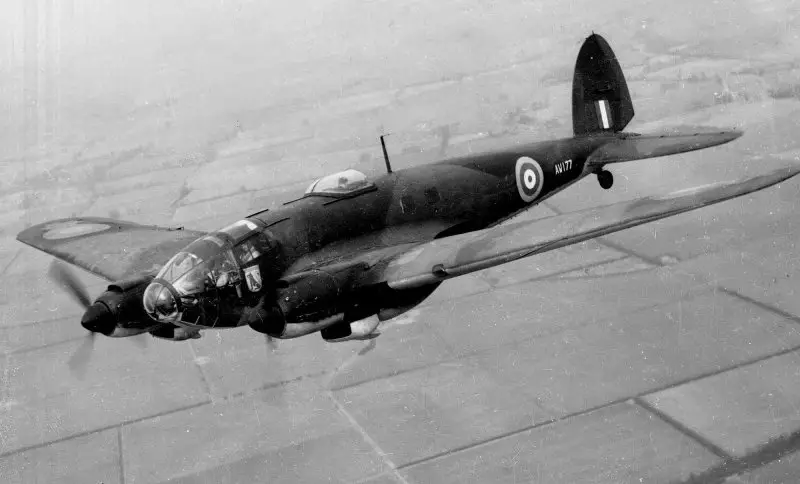
Czechoslovakia operated one He-111 military transport until 1950.
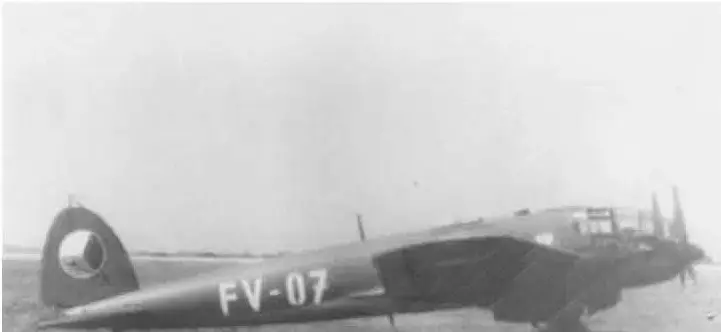
He 111F-1 bombers served in the Turkish Air Force until the late 1940s. Although these aircraft, according to their airframe life, could be operated for approximately another 10 years, the reason for their write-off was the lack of spare parts.
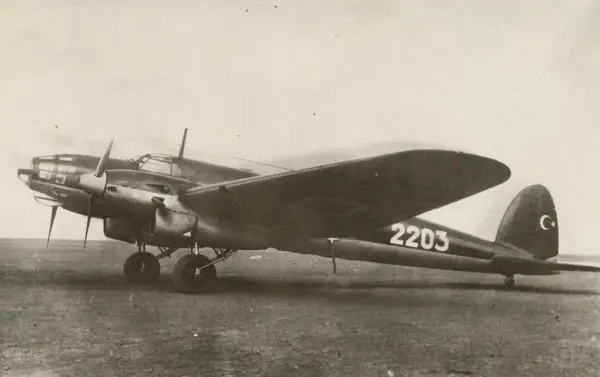
Turkish He 111F-1
The He-111 flew for the longest time in Spain. In addition to the purchase of various modifications of the He-111 in Germany, aircraft production was established at Construcciones Aeronáuticas SA (CASA).
Until 1940, Spain received the He-111 with a “narrow cabin”. Due to the need for more modern bombers, a contract was signed with Heinkel Flugzeugwerke for the joint production of 200 He 111H-16s. Of this number, 120 aircraft were equipped with Jumo 211F-2 engines.
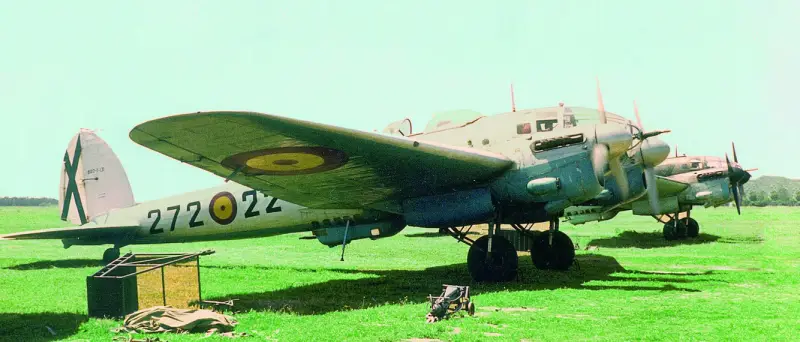
HOME 2.111
At the first stage, the Seville plant assembled three variants: CASA 2.111A - a bomber, CASA 2.111C - a reconnaissance aircraft that could also carry bombs, and CASA 2.111F - a trainer with dual controls. The first Spanish-built aircraft took off after Germany surrendered - on May 23, 1945.

In general, Spanish-built aircraft corresponded to the German He 111H-16, but there were also differences. So, instead of a 13-mm MG 13 machine gun, a coaxial 7,92-mm MG 81Z machine gun and 2 MG-81 (in the side firing points), one 2.111-mm Breda SAFAT and two 12,7-mm MGs were installed on the CASA 7,92 15.
After the end of World War II, the supply of German aircraft engines dried up, and in 1956, British-made Rolls-Royce Merlin 500-29 engines with a power of 1 hp began to be installed on aircraft. With. every. A bomber with such engines received the designation CASA 570B. The reconnaissance version with Merlin is known as CASA 2.111D, the transport and passenger version with a cabin for 2.111 people is CASA 9T. Also, some early-built cars were equipped with British engines.
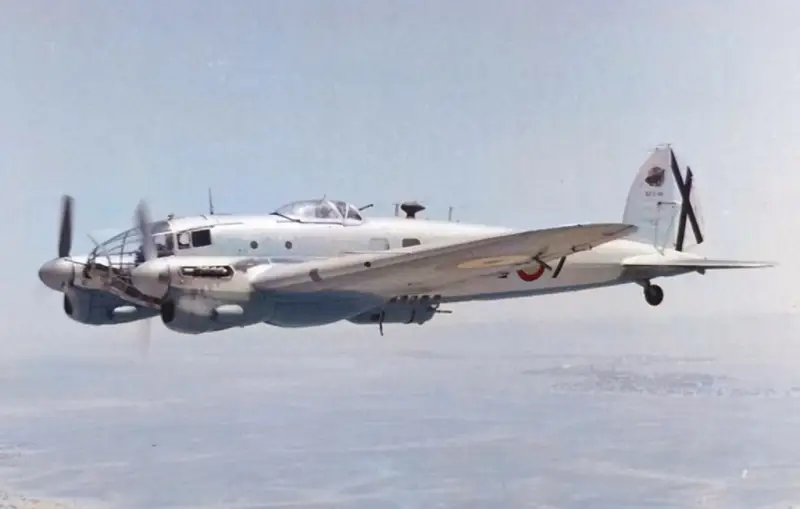
CASA 2.111V
The rate of aircraft production was slow, and CASA 2.111 of various modifications began to play a prominent role in the Spanish Air Force in the late 1940s. In 1957–1958, Spanish-built He 111Ns took part in combat operations in the Sahara. They conducted aerial reconnaissance, supplied besieged garrisons and dropped bombs on Moroccan rebel positions.
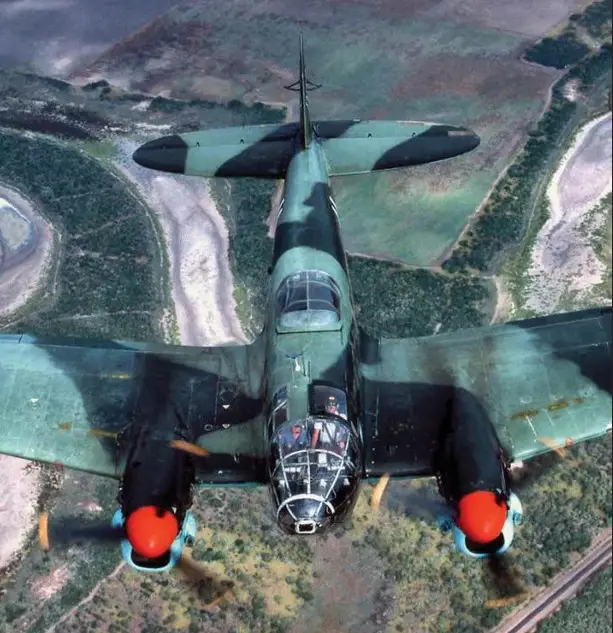
After the advent of the “jet era,” the bulky and slow piston bomber quickly became obsolete. Nevertheless, the operation of reconnaissance and bomber variants in the Spanish air force continued until the mid-1960s. Transport and passenger aircraft served longer; the last CASA 2.111T was written off in 1973.
Due to its similarity to the German He 111H, the Spanish CASA 2.111 was depicted as German bombers in the films "Battle of Britain" and "Patton".
One aircraft, converted from a CASA 2.111F, served for a long time as the personal transport of Spanish dictator Francisco Franco. In 1977, the aircraft was purchased by the American Commemorative Air Force (CAF), and it regularly participated in various air shows, depicting the He 111H.
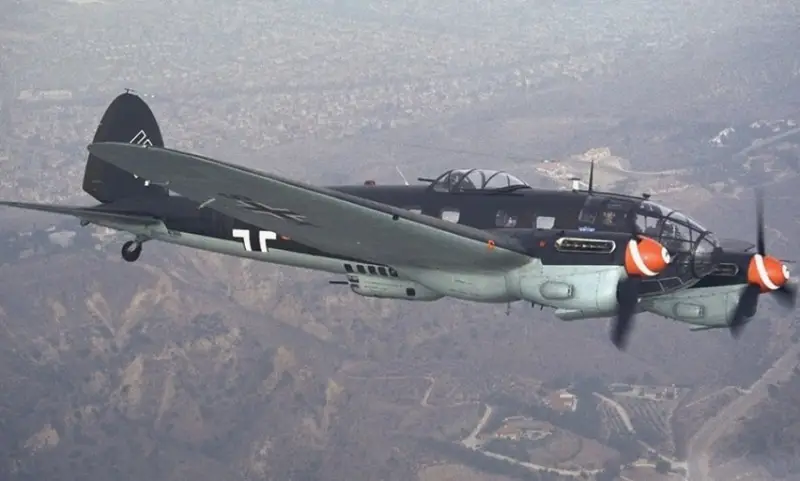
This aircraft remained the only flying example of CASA 2.111 until the crash that occurred on July 10, 2003, when the aircraft crashed on approach to Cheyenne Municipal Airport due to engine failure, burying two pilots in the wreckage.
Junkers Ju 86
At a certain stage, the He 111's competitor was the Ju 86. The design of this aircraft began in 1934, after the Deutsche Luft Hansa airline issued technical specifications for the development of a high-speed airliner for 10 passengers. The idea of creating such an aircraft aroused interest among the military, who needed high-speed bombers.
As a result, specialists from the Ministry of Aviation and Lufthansa developed uniform requirements for a twin-engine aircraft that combines the qualities of a medium bomber and a commercial aircraft. As a result, Heinkel and Junkers received an order to create high-speed dual-purpose aircraft, which led to the appearance of two aircraft that played an important role in the development of military aviation of the Third Reich.
Initially, to increase the flight range, it was planned to equip the prototype aircraft with Jumo 205C diesel engines, but due to their unavailability, the military and passenger prototypes received carburetor star-shaped 9-cylinder Siemens & Halske Sh 22 engines with a power of 590 hp each. With.
The Ju 86ab1 bomber prototype took flight on November 4, 1934. During testing, he managed to reach a speed of 340 km/h.
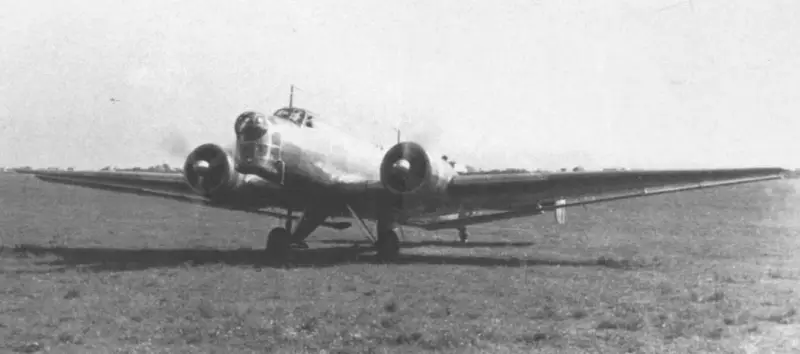
Ju 86ab1
In March 1935, the Ju 86ba1 passenger prototype took off. Inside the rather narrow fuselage there were 10 passenger seats.
Production of combat and civilian versions began at the end of 1935 at the Dassau plant. The pilot batch consisted of 13 bombers and seven passenger aircraft. The first copies left the assembly line in February 1936. Production aircraft were equipped with Jumo-205C-4 diesel engines with a take-off power of 600 hp. With.
A total of 16 civilian Ju 86B and Ju 86C were built, which transported passengers and mail until 1940, after which they were requisitioned by the Luftwaffe. One passenger Ju 86B was equipped with air-cooled engines BMW-132DC with a power of 880 hp. s., which made it possible to slightly increase the speed, but reduced the range.
After the start of trial operation, it became clear that modification of the tail unit was required. The bomber with an extended tail and increased fuel capacity was designated Ju 86D-1.
The aircraft with a maximum take-off weight of 8 kg had a practical flight range of 200 km. The maximum speed at altitude was 2 km, cruising speed was 000 km/h. Ceiling – 320 m. Bomb load – 285 kg. Defensive weapons - three 5 mm MG 900 machine guns. Crew - 800 people.
At the end of 1937, several Ju 86D-1s went to Spain for testing in combat conditions. It soon became clear that the Junkers with diesel engines were significantly inferior to the He 111B bombers, which had gasoline engines.
Since the Jumo 205C diesel engines were not able to quickly change speed (which was required during combat maneuvers), the Ju 86E began to be equipped with 9-cylinder air-cooled gasoline engines BMW 132F with a power of 810 hp. With. (18 aircraft) and BMW 132N with 865 hp. With. (16 aircraft). The mass of the bomb load then reached 1 kg.
The Ju 86G bomber, built in 40 copies, had a fully glazed nose. The machine gun was moved to the right front panel.
However, even with more powerful engines and an improved cabin, the Ju 86 could not keep up with its competitors. In this regard, the designers of the Junkers company focused on the creation of high-altitude reconnaissance aircraft.
In April 1940, conversion of the Ju 86D into high-altitude aircraft that could be used as a reconnaissance aircraft and bomber began. The modification, designated Ju 86P, had a pressurized cabin, an elongated wing and was equipped with Jumo 207A-1 diesel engines (a high-altitude version of the Jumo 205). During testing, the aircraft reached 10 m. The maximum bomb load was 000 kg. But during actual combat missions over Great Britain, reconnaissance and attack Ju 1Ps carried only one 000-kg aerial bomb.
After a certain period of combat use of the Ju 86R, it became clear that in order to maintain invulnerability from fighters and anti-aircraft artillery it was necessary to increase the altitude even further. In the summer of 1942, the Ju 86R with a wingspan of 32 m took to the skies. This aircraft used Jumo-207B-3 diesel engines, which developed 1 hp on takeoff. With. and 000 l. With. at an altitude of 750 m, which, in combination with a new four-bladed propeller, made it possible to fly at an altitude of more than 12 m. Enlarged fuel tanks ensured a flight duration of more than 200 hours. Operation of high-altitude reconnaissance aircraft continued until mid-14.
Although the Ju 86 did not find much fame in the Luftwaffe, this aircraft enjoyed commercial success on the foreign market.
Civilian Junkers with unglazed noses are known as Ju 86Z. These vehicles were equipped with German Jumo 205C diesel engines, British Rolls Royce Kestrel 3 gasoline engines, and American Pratt & Whitney R-1690 Hornet engines. The planes were used as transport or passenger aircraft (cabin for 10 people).
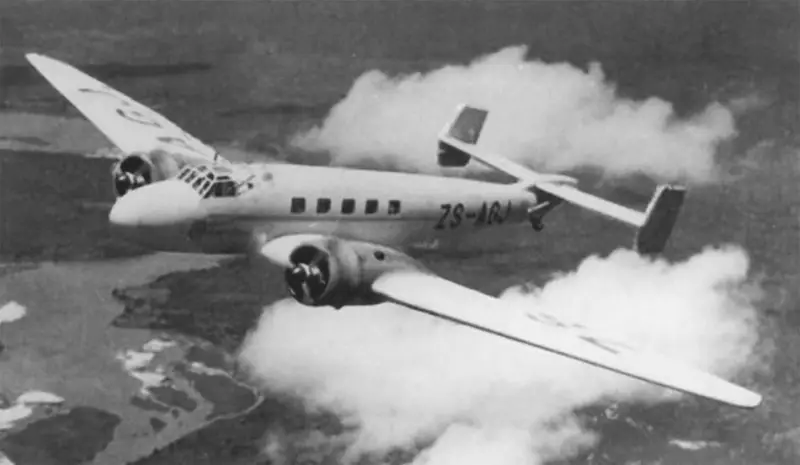
Ju 86Z
Civilian Ju 86Zs were operated in Australia, Bolivia, China, Spain, Switzerland, Sweden, Chile and South Africa.
The first military export modification of the Ju 86K-1 with American air-cooled Pratt & Whitney R-1690 Hornet engines with a power of 760 hp. With. delivered to Sweden (2 aircraft) and South Africa (1 aircraft). In Sweden this bomber was called B 3.
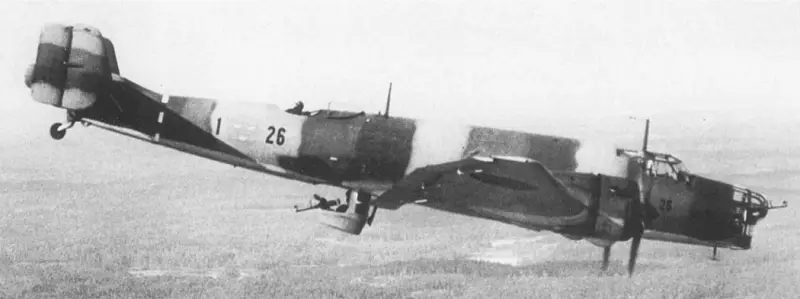
Ju 86K-1
66 Ju 86 K-2 bombers with Gnôme-Rhône 14K Mistral Major engines were built for Hungary.
Ju 86K-4 aircraft (Swedish name B 3A) with 740 hp Bristol Pegasus VI engines. With. 18 units were produced.
The Ju 86K-5 variant (Swedish name B 3B) was built under license by SAAB. Unlike the K-4, Bristol Pegasus XII engines with 880 hp were used. With. The Swedish name is B 3B.
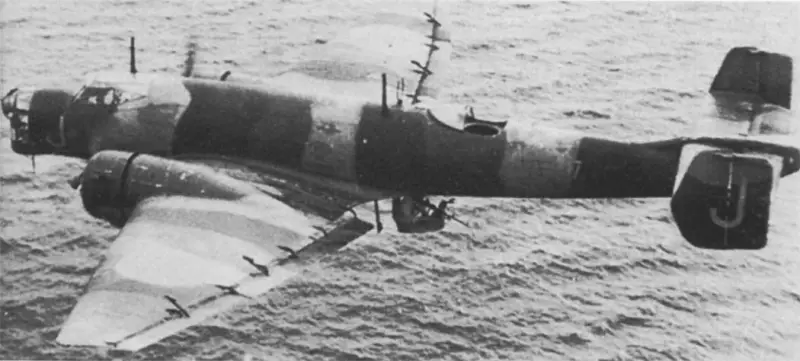
Modifications Ju 86K-6 and Ju 86K-7 (22 units) with Pratt & Whitney R-1690 Hornet engines were produced for Chile and Bolivia. Ten Ju 86K-6s were also purchased by Portugal.
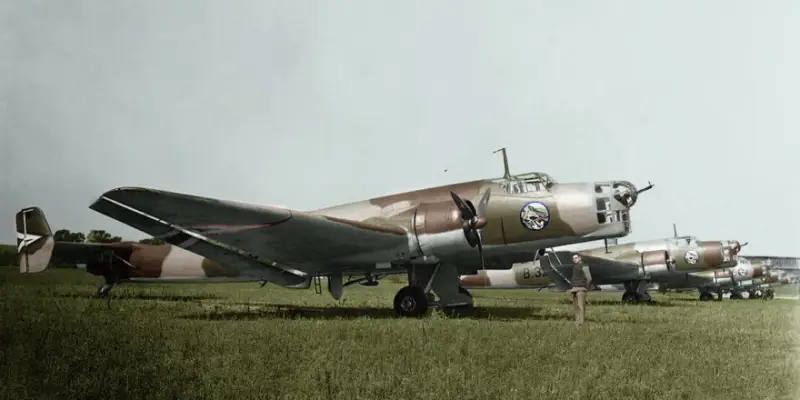
Ju 86K-13 (Swedish designation B 3C) with 980 hp Bristol Mercury XXIV engines. With. and Bristol Mercury XIX with a capacity of 905 hp. With. (on B 3D) were produced under license by SAAB.
Junkers flew in Portugal, Chile and Bolivia until the late 1940s and early 1950s. In 1948, some of the Swedish Ju 86Ks were converted into 12-seat passenger aircraft. The last of them was decommissioned in 1956.
Junkers Ju 88
One of the most successful and versatile Luftwaffe aircraft was the Ju 88. Unlike a number of other German bombers, it was originally intended for military use.
The first flight of the Ju 88V1 prototype took place on December 21, 1936. Soon the experimental aircraft set a record, flying a 1-kilometer route with 000 kg of load on board at an average speed of 2 km/h.
In 1938, serial production of the Ju 88A-1 began with Jumo 211B-1 engines with a take-off power of 1 hp. With. The bomber, which had a maximum take-off weight of 200 kg, could carry a bomb load weighing up to 10 kg. The maximum speed at an altitude of 360 m was 2 km/h. Practical range – 400 km. Ceiling – 5 m. Defensive weapons – three or four 500 mm MG 450 machine guns. Crew – 1 people.
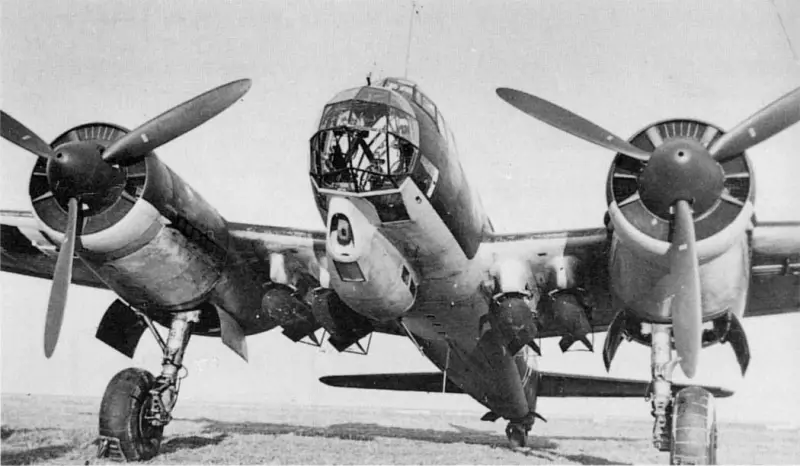
Ju 88A-1 with bombs on external sling
The most popular strike variant was the Ju 88A-4. This modification eliminated the shortcomings of previous models and took into account combat experience. The bomber, produced from mid-1940, had a wingspan increased to 20 m, a reinforced structure and more powerful defensive weapons. It was equipped with 1-horsepower Jumo 340 J-211 engines. The maximum flight speed increased to 1 km/h. The bomb load was 467 kg.
Defensive weapons were also noticeably strengthened. Instead of MG 15 machine guns, faster-firing and easier-to-use MG 81 machine guns were installed, and 13,2 mm MG 131 machine guns were installed on later production vehicles. The crew was 4 people.
Also based on the Ju 88, heavy attack aircraft, heavy day and night fighters, and reconnaissance aircraft were produced. Until the spring of 1945, more than 15 aircraft were built.
Ju 88s were delivered to Hungary, Romania (unspecified number of Ju 88A-4 and Ju 88D-1/D-3), Spain (25 aircraft of various modifications), Italy (6 Ju 88A-7 and 25 Ju 88A-4) and Finland (24 Ju 88A-4). Several serviceable Ju 88s were captured by the British.
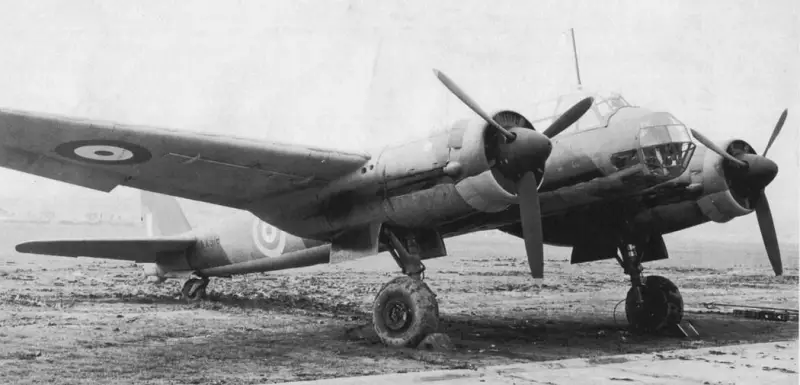
Ju 88 on trials in Great Britain
In the immediate post-war years, several Ju 88s were operated in Romania.
Until 1954, four Ju 88A-4s flew in Finland. Since, following World War II, the Finns were prohibited from having bombers with an internal bomb bay, these aircraft were considered training aircraft.
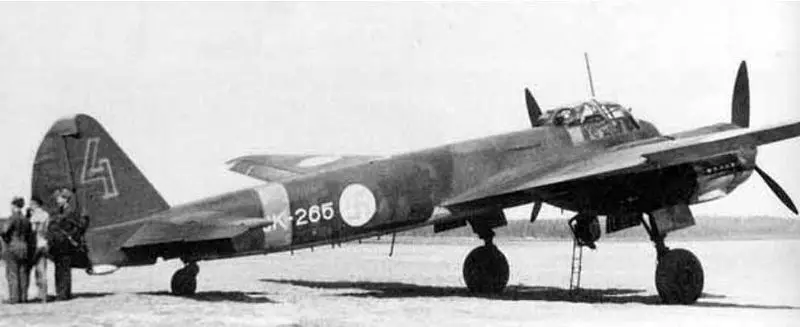
Finnish Ju 88A-4
A significant number of recoverable Ju 88s remained at airfields located in France after the German retreat.
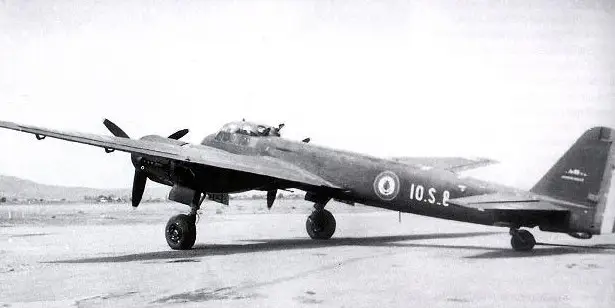
About 15 more captured Ju 88s were handed over to the French by Great Britain and the USA. These aircraft were used by the French Air Force and Naval Aviation until 1950. Basically, French Ju 88s patrolled coastal waters, trained air defense crews and acted as a mock enemy during training interceptions.
Junkers Ju 188
A further development of the Ju 88 was the Ju 188, which differed from its predecessor mainly in the teardrop shape of the cabin, a wing of increased span and a machine gun turret on the roof of the cabin.
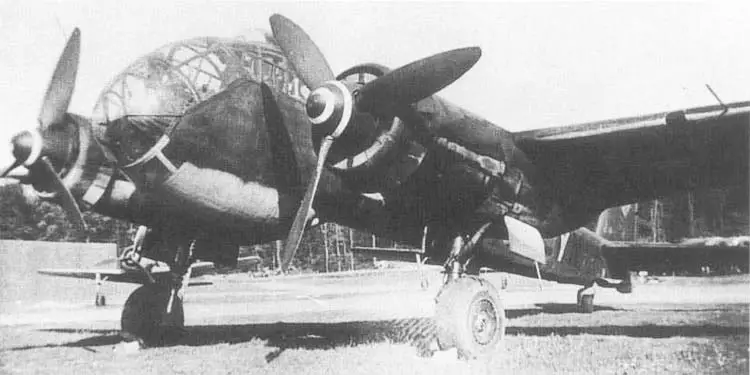
Ju 188A
The prototype took to the skies in September 1941, serial production of the Ju 188A bomber began in February 1943 and continued until August 1944.
In total, 1 aircraft of all modifications were delivered, with 076 aircraft in the reconnaissance version. In August 570, the Ju 1943A was first involved in raids on England, after which it fought until the end of hostilities, mainly on the Western Front.
The Ju 188A-2 modification aircraft with a maximum take-off weight of 15 kg had a practical range of 500 km. Two Jumo 2A-380 engines with afterburning power of 213 hp. With. (nominal 1 hp) could accelerate the aircraft at an altitude of 2 m to 240 km/h. The cruising flight speed was 1 km/h. Service ceiling – 775 m.
Maximum bomb load – 3 kg. Against enemy fighters, a crew of 000 could use a 4-mm MG 20/151 cannon in the forward part of the fuselage, the same cannon in the upper mechanized turret, one 20-mm MG 13,2 machine gun in the rear of the cabin and a 131-mm twin MG-7,92Z firing backwards downwards.
In addition to bombers, torpedo bombers, ground and naval reconnaissance aircraft, attack aircraft with a 188-mm BK-50 cannon in a fairing under the fuselage, day high-altitude fighters and night fighters with radar were built on the basis of the Ju 5.
On 2 May 1945, two Ju 188A bombers landed at Fraserburgh and surrendered to British forces. It is known that these aircraft took to the air until 1946.
Several captured Ju 188E bombers and Ju-188F reconnaissance aircraft with BMW 801MA engines producing 1 hp. With. After the end of the war, they entered service with the French Air Force and Naval Aviation.
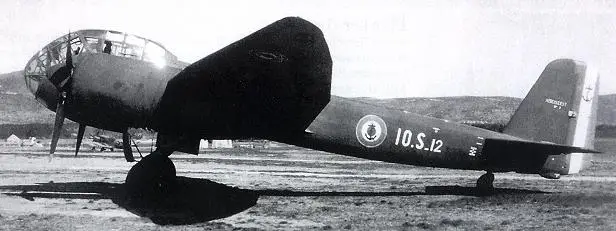
From parts and components captured from German factories, it was possible to manufacture 12 more aircraft of this type. The service of the French Ju 188 ended in 1956.
Продолжение следует ...
Information